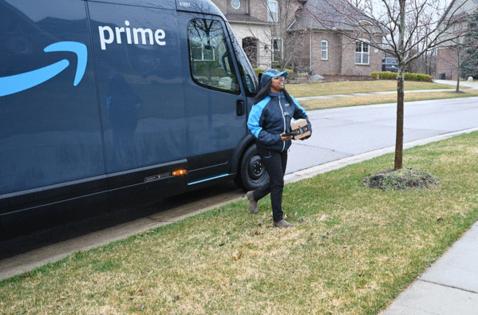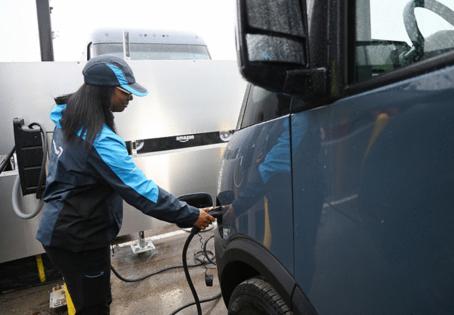Henry Payne: Delivering packages in Rivian's Amazon EV truck
Published in Automotive News
PONTIAC, Michigan — Coming to your Metro Detroit neighborhood, Amazon.com Inc.’s Rivian electric delivery vans are the culmination of a five-year collaboration between the retail giant and the U.S.-based electric vehicle startup.
Michigan is among the major metropolitan areas receiving 100,000 Rivian Automotive Inc. vans that will both meet Amazon’s goal to fully electrify its delivery fleet and give a crucial shot in the arm to the young automaker. They’re also sci-fi chic.
“My family thinks it’s really cool that I’m driving a Rivian truck,” said Kayla Dudley, 24, of Pontiac, Michigan, as she jumped from her van to make a delivery in a Lake Orion suburb. “It makes me want to get an electric car.”
There’s no denying the cool factor of the sleek, head-turning trucks with their cartoonish, LED-rimmed circular headlights, splashy blue rear doors, Amazon smile logo, and Blade Runner-esque red LED light strip framing the rear. If Tesla Inc. took EVs from nerd-mobile to luxury fashion, then Amazon’s Rivian trucks have brought style to the delivery breadbox.
“I like the acceleration. The truck is so seamless to the driver,” said Dudley, who admitted it takes discipline to maintain the speed limit on her daily chores.
That sci-fi style continues inside the cab with twin, digital tablet displays — a hoodless instrument cluster and huge, 15.6-inch dash-mounted tablet. Beginning her shift on a cool, drizzling April morning in Pontiac, Dudley pulled the charger from her cyborg’s front left charger port, then placed it in the 240-volt charger holder. Where these parking spaces once hosted thousands of Detroit Lions fans at the Pontiac Silverdome, they now hold hundreds of Rivian vans to distribute packages from Amazon’s giant fulfillment center, which sits on a 127-acre site.
It's not the first time a delivery service has made its vans icons. UPS has for decades featured its big brown step vans in marketing campaigns. “The Amazon trucks are popping up on social media everywhere,” said auto analyst Sam Fiorani, vice president of vehicle forecasting for Autoforecast Solutions. “UPS designed a truck that was uniquely UPS and that made their service welcome in neighborhoods.”
Rivian’s operating system seamlessly controls the RDV-700 model van (just as in an R1S SUV), which recognized the key fob in Dudley’s pocket and instantly turned on as she stepped into the airy cabin, the gigantic front windscreen a window to the world. With her delivery route already downloaded on her company phone, she scanned a QR code and the Rivian’s screens wirelessly mirrored the route — just as Apple CarPlay would in a passenger car. Ready to rumble.
“Every QR code is a digital (organizer) for packages, vehicles — to make everything easy to sort in the vans,” Dudley said.
The former Silverdome site is dominated by two massive Amazon buildings: an 823,000-square-foot fulfillment center and 174,000-square-foot delivery center. The fulfillment center — 7,000 robots scurrying across its multiple stories — accesses product inventory which is then sent across the street to the delivery center. Their sheer scale also reminds of a sci-fi movie — the Rivian trucks pouring into the giant structure. Or they might be worker ants scurrying to and from a giant anthill.
At 10 a.m., waves of trucks — including Dudley's — decoupled from their chargers to collect their orders. They filed three wide into the delivery center’s west side. Yellow-vested Amazon employees emerged from the building — garage doors zipping automatically upwards as they approached — to help the blue-vested drivers load up. Dudley disappeared inside the enormous facility, re-emerging with a cart full of zip-boxes engorged with 100 packages for delivery this day. On a full day, she’ll deliver 200-300 packages to some 200 homes.
She loaded them into the back of the Rivian’s cargo bay, which is larger than the comparable Dodge Pro Master that she drove when she arrived here three years ago.
Auto fleets have been a target of EV production. Fleets for delivery vans, pickup trucks, ride-share services, rental cars.
Rivian Automotive Inc. saw the opportunity in 2019, securing an exclusive 100,000-unit order with Amazon for delivery by 2024 — a timeline since extended to 2030. The giant order (Rivian has since begun taking orders from other customers), coupled with Amazon capital, gave the EV startup security that has been lacking at peers like Lucid Group Inc. and Fisker Inc.
“The initial startup cost for Amazon is enormous,” said analyst Fiorani, citing the Seattle company’s $1 billion investment and 17% stake in Rivian. “They are not likely to make up that money in the near term. It has the dual purpose of reducing costs and positioning themselves as a green company. And if Rivian is successful in the long term, their investment could pay off financially, too.”
It’s a big bet, as even Tesla has struggled to make fleets work. Hertz has sold off much of its Tesla fleet as promises of cheaper maintenance costs didn’t materialize and customers were turned off the EVs’ inherent range and charging challenges. Despite an aggressive push by Uber to get its drivers into Teslas, ride-share services have also struggled with EV adoption due to high lease rates and long charging times.
Fiorani says that delivery fleets are a better use case for EVs. “The Hertz issue was different because they were trying to make money by renting vehicles to customers,” he said. “But Amazon is developing their service around the van. They are training their employees on how to use it and how to maintain it.”
Amazon’s fleet model is designed to take range anxiety out of the equation with short, routine routes. This routine accommodates the Rivians’ limited, 141-mile range while taking advantage of the inherent strengths of its twin-motor, battery-powered drivetrain: no gas-burning idle time and limited maintenance.
Dudley’s daily route is well within the Rivian’s range. When she's done, she returns the truck to the delivery center, where it is recharged overnight. Drivers are trained to drive the speed limit — not just for safety, but also to limit battery degradation as highway speeds over 70 mph in a van with all the aerodynamics of a brick can quickly suck range.
By noon, Amazon’s worker ants are spread across Oakland County, satisfying Michiganians’ insatiable product needs. Amazon vans often pass each other in the same neighborhood as their pre-planned routes overlap.
Dudley drops her packages from house to house, the Rivian’s motors working silently. In reverse, the Rivian let off a low hum — “it’s like a science fiction movie,” said Dudley — to alert nearby pedestrians.
Her mobile office is posh compared to traditional vans. Not only is it much less cramped, but Dudley has a heated/cooled seat, heated steering wheel, wireless charging pad for her phone and regenerative electric braking. She’s surrounded by a cocoon of safety features, including adaptive cruise control, auto-emergency brake assist, blind-spot assist, three air bags, lane-keep assist and a 360-degree camera view of her surroundings on the screen.
Without an engine up front, the Rivian benefits from EVs’ safe frontal impact dynamics — and the Rivian is designed to shut down and lock its doors whenever she walks away to guard against theft.
Amazon says it has 10,000 vans on the road in 1,800 U.S. sites nationwide, including Midwest cities Detroit, Grand Rapids, Chicago, Toledo, Cleveland, Chicago, Cincinnati, Indianapolis and more.
“No other delivery service is converting to EVs at the scale of Amazon,” analyst Fiorani said. “I’m sure UPS, FedEx and the Postal Service are all looking at this to see if Amazon makes it work.”
____
©2024 www.detroitnews.com. Visit at detroitnews.com. Distributed by Tribune Content Agency, LLC.










Comments